Genre Site-specific art | Dimensions 61 cm x 36 cm x 48 cm Created 1917–1917 Media glazed ceramic, Ceramic | |
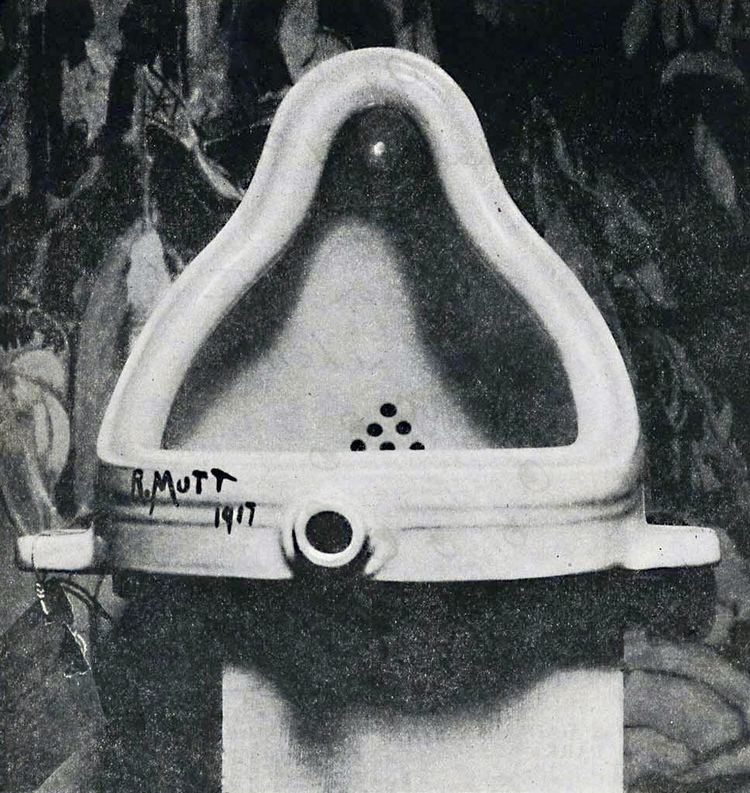 | ||
Similar Bicycle Wheel, Bottle Rack, Étant donnés | ||
Fountain is a 1917 work produced by Marcel Duchamp. The piece was a porcelain urinal, which was signed "R.Mutt" and titled Fountain. Submitted for the exhibition of the Society of Independent Artists, in 1917, the first annual exhibition by the Society to be staged at The Grand Central Palace in New York, Fountain was rejected by the committee, even though the rules stated that all works would be accepted from artists who paid the fee. Fountain was displayed and photographed at Alfred Stieglitz's studio, and the photo published in The Blind Man, but the original has been lost. The work is regarded by art historians and theorists of the avant-garde, such as Peter Bürger, as a major landmark in 20th-century art. 17 replicas commissioned by Duchamp in the 1960s now exist.
Contents
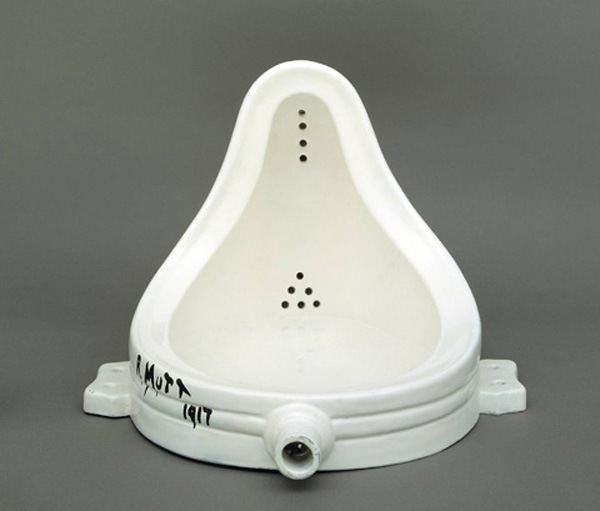
Origin
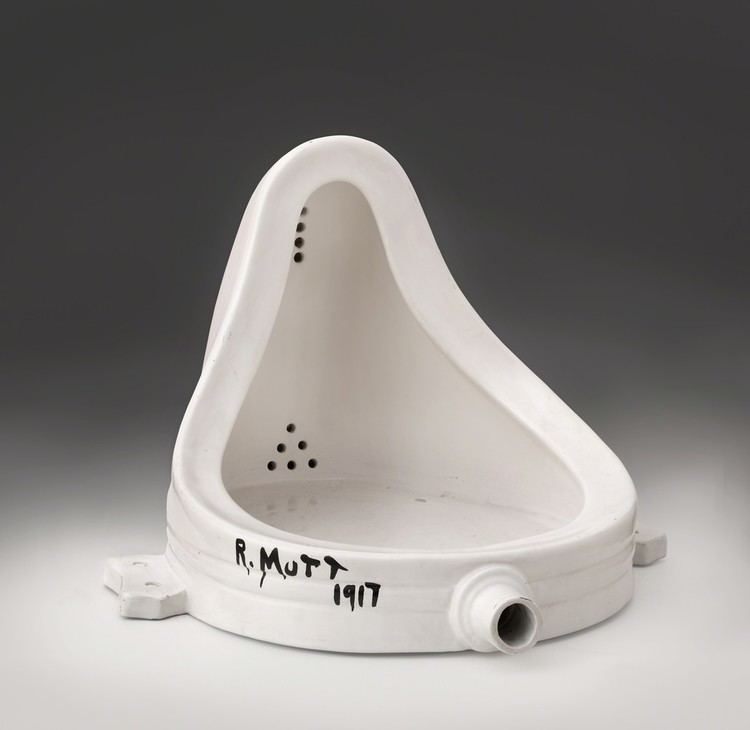
Marcel Duchamp arrived in the United States less than two years prior to the creation of Fountain and had become involved with Dada, an anti-rational, anti-art cultural movement, in New York City. According to one version, the creation of Fountain began when, accompanied by artist Joseph Stella and art collector Walter Arensberg, he purchased a standard Bedfordshire model urinal from the J. L. Mott Iron Works, 118 Fifth Avenue. The artist brought the urinal to his studio at 33 West 67th Street, reoriented it to a position 90 degrees from its normal position of use, and wrote on it, "R. Mutt 1917".
According to another version, Duchamp did not create Fountain, but rather assisted in submitting the piece to the Society of Independent Artists for a female friend. In a letter dated 11 April 1917 Duchamp wrote to his sister Suzanne telling her about the circumstances around Fountain's submission: "Une de mes amies sous un pseudonyme masculin, Richard Mutt, avait envoyé une pissotière en porcelaine comme sculpture" ("One of my female friends, who had adopted the male pseudonym, Richard Mutt, sent me a porcelain urinal as a sculpture.") Duchamp never identified his collaborator, but two candidates have been proposed: the Dadaist Baroness Elsa von Freytag-Loringhoven, whose scatological aesthetic echoed that of Duchamp, or Louise Norton, who contributed an essay to The Blind Man discussing Fountain. Norton, who recently had separated from her husband, was living at the time in an apartment owned by her parents at 110 West 88th Street in New York City, and this address is partially discernible (along with "Richard Mutt") on the paper entry ticket attached to the object, as seen in Stieglitz's photograph.
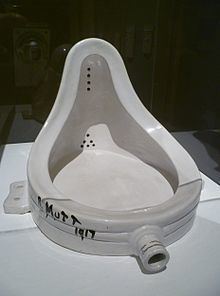
Rhonda Roland Shearer in the online journal Tout-Fait (2000) has concluded that the photograph is a composite of different photos, while other scholars such as William Camfield have never been able to match the urinal shown in the photo to any urinals found in the catalogues of the time period.
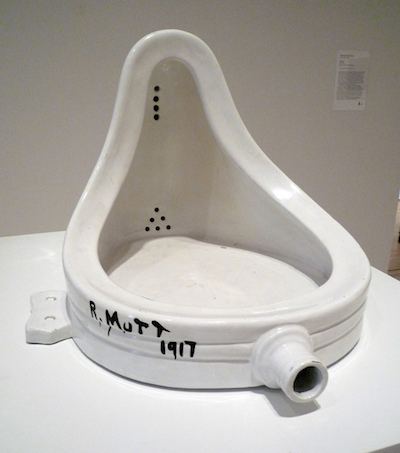
At the time Duchamp was a board member of the Society of Independent Artists. After much debate by the board members (most of whom did not know Duchamp had submitted it) about whether the piece was or was not art, Fountain was hidden from view during the show. Duchamp resigned from the Board in protest.
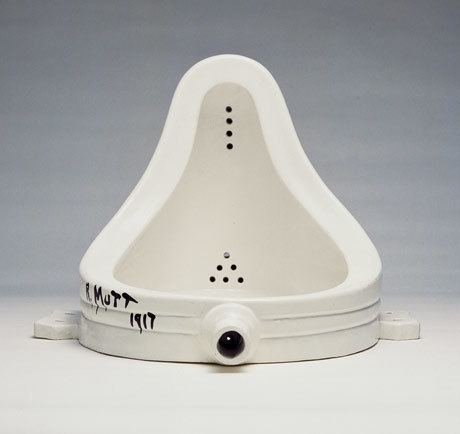
The New York Dadaists stirred controversy about Fountain and its being rejected in the second issue of The Blind Man which included a photo of the piece and a letter by Alfred Stieglitz, and writings by Beatrice Wood and Arensberg. The anonymous editorial (which is assumed to be written by Wood) accompanying the photograph, entitled "The Richard Mutt Case," made a claim that would prove to be important concerning certain works of art that would come after it:
Whether Mr Mutt with his own hands made the fountain or not has no importance. He CHOSE it. He took an ordinary article of life, placed it so that its useful significance disappeared under the new title and point of view – created a new thought for that object.
In defense of the work being art, Wood also wrote, "The only works of art America has given are her plumbing and her bridges." Duchamp described his intent with the piece was to shift the focus of art from physical craft to intellectual interpretation.
Menno Hubregtse argues that Duchamp may have chosen Fountain as a readymade because it parodied Robert J. Coady's exaltation of industrial machines as pure forms of American art. Coady, who championed his call for American art in his publication The Soil, printed a scathing review of Jean Crotti's Portrait of Marcel Duchamp (Sculpture Made to Measure) in the December 1916 issue. Hubregtse notes that Duchamp's urinal may have been a clever response to Coady's comparison of Crotti's sculpture with "the absolute expression of a—plumber."
Shortly after its initial exhibition, Fountain was lost. According to Duchamp biographer Calvin Tomkins, the best guess is that it was thrown out as rubbish by Stieglitz, a common fate of Duchamp's early readymades.
The first reproduction of Fountain was authorized by Duchamp in 1950 for an exhibition in New York; two more individual pieces followed in 1953 and 1963, and then an artist's multiple was manufactured in an edition of eight in 1964. These editions ended up in a number of important public collections; Indiana University Art Museum, San Francisco Museum of Modern Art, the National Gallery of Canada, Centre Georges Pompidou and Tate Modern. The edition of eight was manufactured from glazed earthenware painted to resemble the original porcelain, with a signature reproduced in black paint.
Interpretations
Of all the artworks in this series of readymades, Fountain is perhaps the best known because the symbolic meaning of the toilet takes the conceptual challenge posed by the readymades to their most visceral extreme. Similarly, philosopher Stephen Hicks argued that Duchamp, who was quite familiar with the history of European art, was obviously making a provocative statement with Fountain:
The artist is a not great creator—Duchamp went shopping at a plumbing store. The artwork is not a special object—it was mass-produced in a factory. The experience of art is not exciting and ennobling—at best it is puzzling and mostly leaves one with a sense of distaste. But over and above that, Duchamp did not select just any ready-made object to display. In selecting the urinal, his message was clear: Art is something you piss on.Since the photograph taken by Stieglitz is the only image of the original sculpture, there are some interpretations of "Fountain" by looking not only at reproductions but this particular photograph. Tomkins notes that "it does not take much stretching of the imagination to see in the upside-down urinal's gently flowing curves the veiled head of a classic Renaissance madonna or a seated Buddha or, perhaps more to the point, one of Brâncuși's polished erotic forms."
Title of the work
The use of the word "Dada" for the art movement, the meaning (if any) and intention of both the piece and the signature "R. Mutt", are difficult to pin down precisely. It is not clear whether Duchamp or Freytag-Lorinhoven had in mind the German "Armut" (meaning "poverty"), or possibly "Urmutter" (meaning “great mother”). If we separate the capital and lowercase letters we get "R.M" and "utt", "R.M" would stand for "Readymade" which is the fountain itself and "utt" when read out loud sounds like "eut été" in French (much like Duchamp's L.H.O.O.Q.). The name R. Mutt is a play on its commercial origins and also on the famous comic strip of the time, Mutt and Jeff (making the urinal perhaps the first work of art based on a comic). In German, Armut means poverty, although Duchamp said the R stood for Richard, French slang for "moneybags", which makes Fountain a kind of scatological golden calf.
Legacy
In December 2004, Duchamp's Fountain was voted the most influential artwork of the 20th century by 500 selected British art world professionals. The Independent noted in a February 2008 article that with this single work, Duchamp invented conceptual art and "severed forever the traditional link between the artist's labour and the merit of the work".
Jerry Saltz wrote in The Village Voice in 2006:
Duchamp adamantly asserted that he wanted to "de-deify" the artist. The readymades provide a way around inflexible either-or aesthetic propositions. They represent a Copernican shift in art. Fountain is what's called an "acheropoietoi," [sic] an image not shaped by the hands of an artist. Fountain brings us into contact with an original that is still an original but that also exists in an altered philosophical and metaphysical state. It is a manifestation of the Kantian sublime: A work of art that transcends a form but that is also intelligible, an object that strikes down an idea while allowing it to spring up stronger.
The prices for replicas, editions, or works that have some ephemeral trace of Duchamp reached its peak with the purchase of one of the eight 1964 replicas of "Fountain" for $1.7 million at Sotheby's in November 1999.
Interventions
Several performance artists have attempted to "contribute" to the piece by urinating in it. South African born artist Kendell Geers, rose to international notoriety in 1993 when, at a show in Venice, he urinated into the Fountain. Artist / musician Brian Eno declared successfully urinating in the Fountain while exhibited in the MOMA in 1993. He admitted that it was only a technical triumph because he needed to urinate in a tube in advance so he could get the fluid through a gap between the protective glass. Swedish artist Björn Kjelltoft urinated in the Fountain at Moderna Museet in Stockholm in 1999.
In spring 2000, Yuan Chai and Jian Jun Xi, two performance artists, who in 1999 had jumped on Tracey Emin's installation-sculpture My Bed in the Turner Prize exhibition at Tate Britain, went to the newly opened Tate Modern and urinated on the Fountain which was on display. However, they were prevented from soiling the sculpture directly by its Perspex case. The Tate, which denied that the duo had succeeded in urinating into the sculpture itself, banned them from the premises stating that they were threatening "works of art and our staff." When asked why they felt they had to add to Duchamp's work, Chai said, "The urinal is there – it's an invitation. As Duchamp said himself, it's the artist's choice. He chooses what is art. We just added to it."
On January 4, 2006, while on display in the Dada show in the Pompidou Centre in Paris, Fountain was attacked by Pierre Pinoncelli, a 76-year-old French performance artist, with a hammer causing a slight chip. Pinoncelli, who was arrested, said the attack was a work of performance art that Marcel Duchamp himself would have appreciated. In 1993 Pinoncelli urinated into the piece while it was on display in Nimes, in southern France. Both of Pinoncelli's performances derive from neo-Dadaists' and Viennese Actionists' intervention or manoeuvre.
Afterword
Duchamp is often misquoted as saying:
This Neo-Dada, which they call New Realism, Pop Art, Assemblage, etc., is an easy way out, and lives on what Dada did. When I discovered the ready-mades I sought to discourage aesthetics. In Neo-Dada they have taken my readymades and found aesthetic beauty in them, I threw the bottle-rack and the urinal into their faces as a challenge and now they admire them for their aesthetic beauty.
However, fellow Dadaist Hans Richter explained years later that it was in a letter he had written to Duchamp in 1961, except in the second person not the first, i.e. "You threw..." etc. Duchamp had written in French, "Ok, ça va très bien" ("Ok, that works very well") in the margin beside it.
